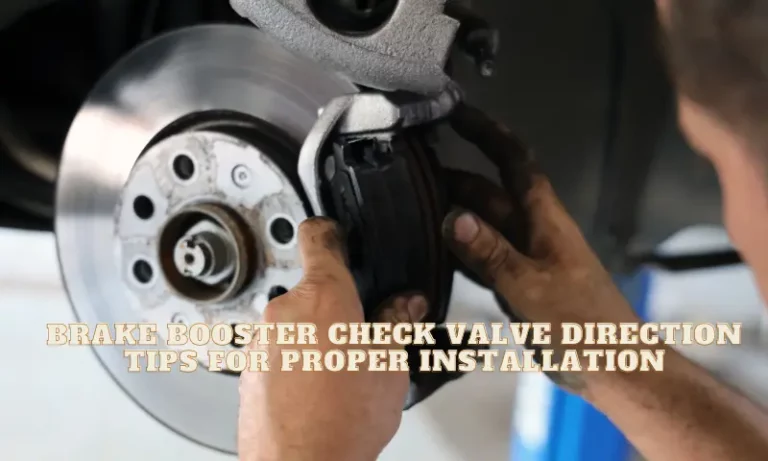Is just pressing the brake pedal enough to produce the amount of pressure needed for braking? There must be something other than that. It is good to familiarize yourself with the special components of your vehicle and some terminologies in the auto world.
One such is the brake booster check valve. It’s quite difficult to install but easy to install the wrong way. How can the installation affect your braking performance? In this article, I’ve provided insights into the right techniques to integrate this critical component into your vehicle. Keep reading.
Summary of How the Brake Booster Works
The function of the brake booster is to provide assistance and improve your vehicle’s braking performance. When you press your brake pedal, the brake booster adds more force to it through the engine vacuum. Usually, there is a shaft that comes directly from the brake pedal to the brake booster and then to the master cylinder.
A brake booster has two sides with a diaphragm separating them. The vacuum pump supplies vacuum to the two sides of the brake booster. Each time you press your brake pedal, the shaft changes position forward, allowing the passage of air into one side of the booster.
The air moves in freely due to the pressure from the change in the position of the shaft. The shaft then opens up the valve in the booster and pushes the piston into the master cylinder. In effect, the master cylinder releases brake fluid to stop the vehicle.
Thanks to the brake booster, you do not need to exert all your force just to bring your car to a halt. What happens to the air inside the brake booster?
Vacuum Brake Booster Check Valve and Its Direction
To prevent your braking performance from diminishing, air molecules must not enter the cylinder. Thus, the check valve helps to prevent the hair from the brake booster from penetrating the master cylinder and the brake lines. A check valve connects the vacuum hose to the brake booster.
The check valve maintains the vacuum trapped in the brake booster. Interestingly, the check valve is a one-way valve that expels air out of the brake booster but never allows air into the brake booster.
The check valve direction must be away from the booster and towards the engine since air can only flow through in one direction. This is to ensure that the vacuum is maintained only in the brake booster. If the check valve is fixed backwards, it hinders the vacuum from getting to the booster.
Therefore, its high-pressure side must be directed towards the brake booster. Usually, there is an arrow on the valve’s housing that indicates the flow direction. If there isn’t an arrow, try to examine the valve to ensure it is installed in the intended flow direction.
How to Properly Install a Brake Booster Check Valve
Here’s a step-to-step guide to replace and install a brake booster check valve direction the right way:
Step 1 Locate the brake booster check valve: Find the brake booster check valve either on the brake booster or in line with the vacuum hose.
Step 2: Spray WD-40 cleaner: Check the rubber O-ring and spray some WD-40 fluid. This will enable you easily to twist, loosen, and pull out the valve.
Step 3: Unscrew the gear type clamp: Once you’re able to find the brake booster check valve, it’s time to locate the gear type clamp. Once done, then you should loosen the screw, using a Philips head screwdriver.
Step 4: Press the spring-type clam tabs: Check for a spring-type clamp and press the tabs together with a plier.
Step 5: Take off the vacuum hose: Remove the vacuum hose from the barber end of the check valve. Remove the check valve by twisting and pulling it. Make sure the rubber grommet does not fall out with the old check valve. If it does, return it to its original position.
Step 7: Pull out the in-line brake booster check valve: You can now remove the in-line brake booster check valve from the intake manifold or vacuum hose.
If you successfully remove your old check valve with the steps above, then you’re good to go. Believing that you have your new check valve at hand, then it’s time to install the new one.
Take the following steps to install the new brake booster check valve.
- Push the new check valve back into the rubber grommet.
- Insert the vacuum hose onto the bartender end of the valve
- Fix the clamps back to their position.
Read also: Not Enough Vacuum for Brake Booster: Causes and Fixes
FAQs
Is the check valve available in all brake boosters?
Of course, the check valve is available in all brake boosters. It is an important component of the brake booster. The check valve helps to get rid of the air trapped in the vacuum booster and to maintain the level of moisture.
Will a faulty check valve affect my brakes?
If your check valve is faulty or not properly installed, it will generate issues when you apply your brake. Your brake pedal may become stiff which could result in an accident. In addition, it can cause the engine to stall due to unregulated vacuum or leakage.
Final Wrap
The result of a bad Brake Booster Check Valve is a hard or aggressive brake pedal. When you release your brake pedal, the already compounded pressure in the booster will need an exit. That is why the check valve has to be in good working condition and properly installed to defuse the pressure from the vacuum booster.
Otherwise, the built-up pressure will remain or become continuously exerted on other braking parts. Either way can cause severe damage. A Brake Booster Check Valve issue is no child’s play. In light of that, it is recommended that you seek the attention of a qualified and reliable mechanic. I hope you find this article useful.



